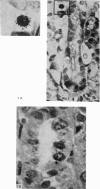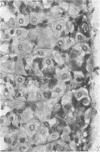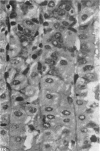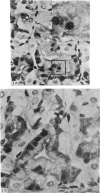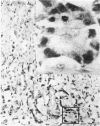Abstract
Six to eight week old male mice of C3Hf/Bu strain were killed and studied at various times from 30 minutes to 30 days after tritiated thymidine (3H-TdR) injection. Labelling of parietal and zymogen cells was observed in autoradiographic histological specimens. There were 590 +/- 22 gastric glands per circumference at the body of the stomach. Parietal cells were counted as 16-2 (14-0-18-4) per gland or 9600 per circumference. There were 11-4 (9-4-13-7) zymogen cells per gland or 6700 per circumference. Two labelled immature parietal cells per circumference were seen 30 minutes after 3H-TdR injection, equivalent to a ratio of 1:5000; more mature labelled parietal cells were seen at later times up to 30 days. There was evidence for proliferation during maturation and downward migration of cells toward the body and the lower part of the gastric gland. Our data support earlier evidence that immature parietal cells constantly supply mature parietal cells through migration from a proliferative zone. Whether the parietal cells are derived from the same stem cell compartment as surface epithelium cells is unclear at the present time. An average of 2-6 zymogen cells per circumference, or 1:2500, was found to be labelled. While most zymogen cells were not proliferating, cells entered the proliferating cycle at random. Based on the findings reported in this paper and the radiation responses of both parietal and zymogen cells, it is postulated that they form part of a slow renewal system.
Full text
PDF











Images in this article
Selected References
These references are in PubMed. This may not be the complete list of references from this article.
- CREAMER B., SHORTER R. G., BAMFORTH J. The turnover and shedding of epithelial cells. I. The turnover in the gastro-intestinal tract. Gut. 1961 Jun;2:110–118. doi: 10.1136/gut.2.2.110. [DOI] [PMC free article] [PubMed] [Google Scholar]
- Chen K. Y., Withers H. R. Survival characteristics of stem cells of gastric mucosa in C 3 H mice subjected to localized gamma irradiation. Int J Radiat Biol Relat Stud Phys Chem Med. 1972 Jun;21(6):521–534. doi: 10.1080/09553007214550621. [DOI] [PubMed] [Google Scholar]
- Corpron R. E. The ultrastructure of the gastric mucosa in normal and hypophysectomized rats. Am J Anat. 1966 Jan;118(1):53–90. doi: 10.1002/aja.1001180105. [DOI] [PubMed] [Google Scholar]
- HUNT T. E., HUNT E. A. Radioautographic study of proliferation in the stomach of the rat using thymidine-H3 and compound 48/80. Anat Rec. 1962 Apr;142:505–517. doi: 10.1002/ar.1091420408. [DOI] [PubMed] [Google Scholar]
- HUNT T. E. Mitotic activity in the gastric mucosa of the rat after fasting and refeeding. Anat Rec. 1957 Mar;127(3):539–550. doi: 10.1002/ar.1091270305. [DOI] [PubMed] [Google Scholar]
- Hattori T. On cell proliferation and differentiation of the fundic mucosa of the golden hamster. Fractographic study combined with microscopy and 3H-thymidine autoradiography. Cell Tissue Res. 1974 Apr 11;148(2):213–226. doi: 10.1007/BF00224583. [DOI] [PubMed] [Google Scholar]
- Hughes W. L., Bond V. P., Brecher G., Cronkite E. P., Painter R. B., Quastler H., Sherman F. G. CELLULAR PROLIFERATION IN THE MOUSE AS REVEALED BY AUTORADIOGRAPHY WITH TRITIATED THYMIDINE. Proc Natl Acad Sci U S A. 1958 May;44(5):476–483. doi: 10.1073/pnas.44.5.476. [DOI] [PMC free article] [PubMed] [Google Scholar]
- Kaku H. [Dynamic analysis of the stomach epithelium - 3H-thymidine autoradiographic study]. Arch Histol Jpn. 1966 Nov;27(1):223–246. doi: 10.1679/aohc1950.27.223. [DOI] [PubMed] [Google Scholar]
- Kataoka K. Electron microscopic observations on cell proliferation and differentiation in the gastric mucosa of the mouse. Arch Histol Jpn. 1970 Sep;32(3):251–273. doi: 10.1679/aohc1950.32.251. [DOI] [PubMed] [Google Scholar]
- LAWN A. M. Observations on the fine structure of the gastric parietal cell of the rat. J Biophys Biochem Cytol. 1960 Feb;7:161–166. doi: 10.1083/jcb.7.1.161. [DOI] [PMC free article] [PubMed] [Google Scholar]
- LIPKIN M., SHERLOCK P., BELL B. CELL PROLIFERATION KINETICS IN THE GASTROINTESTINAL TRACT OF MAN. II. CELL RENEWAL IN STOMACH, ILEUM, COLON, AND RECTUM. Gastroenterology. 1963 Dec;45:721–729. [PubMed] [Google Scholar]
- MESSIER B., LEBLOND C. P. Cell proliferation and migration as revealed by radioautography after injection of thymidine-H3 into male rats and mice. Am J Anat. 1960 May;106:247–285. doi: 10.1002/aja.1001060305. [DOI] [PubMed] [Google Scholar]
- Ragins H., Wincze F., Liu S. M., Dittbrenner M. Theorigin and survival of gastric parietal cells in the mouse. Anat Rec. 1968 Sep;162(1):99–110. doi: 10.1002/ar.1091620109. [DOI] [PubMed] [Google Scholar]
- STEVENS C. E., LEBLOND C. P. Renewal of the mucous cells in the gastric mucosa of the rat. Anat Rec. 1953 Feb;115(2):231–245. doi: 10.1002/ar.1091150206. [DOI] [PubMed] [Google Scholar]
- TEIR H., SCHAUMAN A., SUNDELL B. Mitotic ratio and colchicine sensitivity of the stomach epithelium of the white rat. Acta Anat (Basel) 1952;16(1-2):233–244. doi: 10.1159/000140778. [DOI] [PubMed] [Google Scholar]
- Willems G., Galand P., Vansteenkiste Y., Zeitoun P. Cell population kinetics of zymogen and parietal cells in the stomach of mice. Z Zellforsch Mikrosk Anat. 1972;134(4):505–518. doi: 10.1007/BF00307670. [DOI] [PubMed] [Google Scholar]



